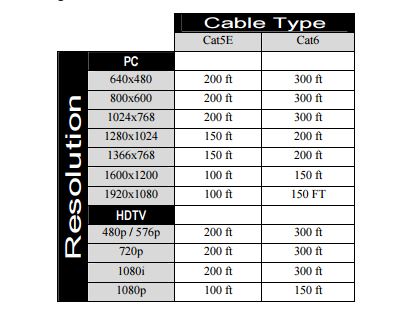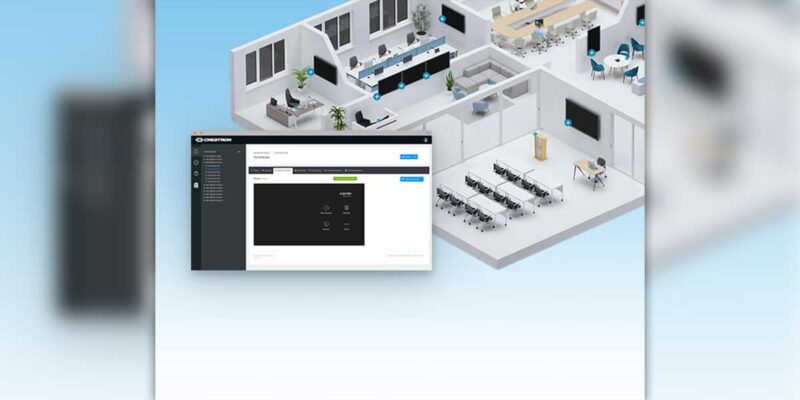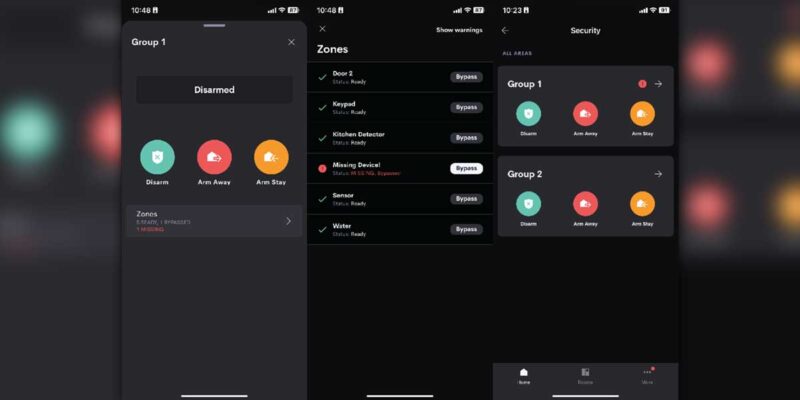The HDBaseT Band Aid
As a former integrator and someone who had to deal with the frustration of specifying HD video extenders, I have to say that even I was initially excited about the introduction of HDBaseT. Being able to reliably extend 1080p signals up to 300 feet over copper was a necessity in most of the jobs I worked on, and the old HDMI extenders were hit or miss at best. Some used a single CatX and others used two. And then, there was the infamous matrix of resolutions, clock rates, and distances.
I’d procure an extender that said 1080p up to 300 ft on Cat5e or Cat6 only to find that the 300 feet only applies to 480p on Cat6 and 1080p only goes 100 feet on Cat5e. If I never have to see a matrix like this again it will be too soon.
Then even if the extender bench tested in the office on a spool of cable, it many times performed differently in the field depending on whether there was EMF in the area or even grounding issues with the electrical. It was a mess.
HDBaseT changed that. All of a sudden 1080p at 300 feet over copper was a reality and it also carried data to boot. Awesome.
HDBaseT also carries with it the idea of a standard. The HDBaseT Alliance actually has a quality standard as well as a testing system to verify products all work. Now, there has been some criticism of HDBaseT in that it doesn’t require every product it certifies to support all the features in the max “5 Play” standard, and that it may be difficult to interpret which of those features each individual product supports. To their credit, HDBaseT has put together an installer zone to help educate us on all that.
To be honest, I’d rather deal with the questions of “5 Play” then go back to the old extenders which very often resulted in “no play”.
 Sometimes when we are in “trouble” mode we accept solutions without really questioning the longer term implications.
Sometimes when we are in “trouble” mode we accept solutions without really questioning the longer term implications.
I have to admit that it took a little while for me to see the truth about HD-BaseT. It is a Band Aid.
To grasp exactly what I mean, we all have to come to terms with a truth that may be hard to swallow.
We are now a subset of the IT industry.
“Says who?”, you ask? Why none other than InfoComm CEO David Labuskes.
“We need to acknowledge the fact that AV is a specialty that lives within the Information Technology Communications community. The way I talk about this at this point is in the medical industry we have cardiologists and podiatrists and dermatologists and neurosurgeons. The fact is that they all have an MD but they all have various specialties and we as a society recognize and understand the need for those specializations…The fact is that AV is a specialty that focuses on people and the experience.”
Given that we are a subset of the IT industry, there is one very important piece of equipment that we should be embracing… the switch. This is why I say that HDBaseT is the largest work around in AV/IT convergence. It is delaying the inevitable, that we will need to move all of this video traffic through the switch eventually.
It seems that HDBaseT may have missed a huge opportunity to be part of that solution.
Let me explain that a little further. HDBaseT utilizes the Pulse Amplitude Modulation (PAM) to facilitate moving all that data. PAM is also the methodology used in an ethernet switch. However, there is a huge differentiator. HDBaseT uses a proprietary PAM strategy that is not compatible with the ethernet protocol.
According to Daniel Schwartzberg, a member of the HDBaseT Alliance and an employee of Valens Semiconductor who makes the HDBaseT chips,
“HDBaseT uses Pulse Amplitude Modulation, PAM, with 16 levels…Unfortunately though it’s not ethernet. It’s encapsulated differently, it is packetized but it’s not packetized as ethernet, and therefore it’s not suitable for ethernet switching. The technology is switchable…we’re going to have the ability to purchase HDBaseT switch ICs which will enable us to do packet switching and generate those sort of applications, those sort of topologies and configurations you would get from an ethernet switch but using an HDBaseT switch.”
My gut tells me this is packetized differently by design. After all Valens is in the hardware business. They also partnered early on with Crestron in the R&D and introduction of the DM product line to vet HDBaseT in the market. If I were Valens, I would have also seen Crestron as a great company to partner with for this type of development and market test. On the flip side, besides it’s high end prowess, Crestron is also known for being one of the most proprietary and closed loop systems out there. Not exactly the partner I would seek for a standards based project.
It seems like it would have been more intuitive to take an “Apollo 13 approach” to this venture. “We need to move this amount of data from point A to point B using this.”
Now many of you are saying this just can’t be done without unacceptable compromises. I respond by saying that you are probably the same people who tell everyone that Netflix streamed movies are just fine so you don’t buy Blu-Rays. Pick a side and stick with it. But I digress.
Let’s assume you’re right. For argument’s sake we’ll assume that the switch as it is today, even the 10G switch, is not suitable for HD video switching. Others have made that same argument, so I’ll run with it. Kevin Iselli of Crestron has stated that there will never be a perfect molding of AV and IT because
“…one does not lend itself to the ultimate performance of the other…we need to have that quality assurance…we will never get that out of ethernet.”
He then paraphrased a statement Mr. Feldstein gave at a manufacturer’s forum at InfoComm,
“If we want this to make it’s way into the world as a reality, meaning a convergent network…we have to change the network and that’s just not gonna happen.”
I don’t question Mr. Feldstein’s intelligence, (even I’m not that dumb), but I do pose this question:
Could the same argument have been made when proposing POE and 10G as new ethernet switch protocols? Of course the legacy investment in ethernet cannot just be ignored, and companies will not buy all new switch architecture just for video distribution, but in the vein of 10G and POE, could there not have been a way to incorporate HDBaseT compatible ports into hybrid switches where a number of the ports are plain ethernet, and the others support ethernet and HDBaseT? Could the data not have been packetized in a way compatible with ethernet and passed through switches with higher throughput back planes and HDBaseT ports?
It’s a question I don’t have the answer to but I’d love someone with deep knowledge of PAM and packetizing data to comment on this as it is something I have great interest in.
At the end of the day however, IT folks will only support our parallel networks and proprietary switching platforms for the short term. In the long term, they see an advantage to having everything on one network, given it is secure. This is why HDBaseT is a stop gap and not the endgame.
Just like Netflix streaming now dominates at-home movie consumption, quality compromises will inevitably be made to move video through the network. The same people who accept Skype and Netflix quality in their homes and personal media will be making those decisions in their businesses based on convenience and manageability.
The point, don’t get distracted. Use HDBaseT as you need to in your business, but don’t ignore the longer process of developing the IT skill sets needed to be able to move video across the switch. You will need them in the near future.
If you don’t develop them, you will not be unlike the 3 wise men in The Life of Brian, who show up at the wrong house, and then follow Brian around as the Savior, while all the while, in the background, you never notice the larger multitude following the one who will really deliver you to the promised land.
In the words of Brian’s mother,






